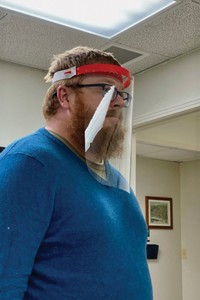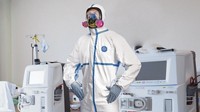Advertisement
Grab your lab coat. Let's get started
Welcome!
Welcome!
Create an account below to get 6 C&EN articles per month, receive newsletters and more - all free.
It seems this is your first time logging in online. Please enter the following information to continue.
As an ACS member you automatically get access to this site. All we need is few more details to create your reading experience.
Not you? Sign in with a different account.
Not you? Sign in with a different account.
ERROR 1
ERROR 1
ERROR 2
ERROR 2
ERROR 2
ERROR 2
ERROR 2
Password and Confirm password must match.
If you have an ACS member number, please enter it here so we can link this account to your membership. (optional)
ERROR 2
ACS values your privacy. By submitting your information, you are gaining access to C&EN and subscribing to our weekly newsletter. We use the information you provide to make your reading experience better, and we will never sell your data to third party members.
Support nonprofit science journalism
C&EN has made this story and all of its coverage of the coronavirus epidemic freely available during the outbreak to keep the public informed. To support us:
Donate Join Subscribe
Polymers
Covid-19
Plastics during the pandemic
COVID-19 has meant a shift in plastics markets, and polymer makers are hustling to keep up
by Alexander H. Tullo
June 22, 2020
| A version of this story appeared in
Volume 98, Issue 24
Braskem went to extraordinary lengths to keep the polypropylene flowing during the early days of the COVID-19 pandemic.

In March, with lockdown orders shutting the US, workers volunteered to live at the company’s plants in Pennsylvania and West Virginia for 28 days to isolate themselves from the novel coronavirus. The employees received extra compensation and prepared their meals in on-site kitchens. They churned out polymers used for the nonwoven fibers that go into N95 masks and other protective gear.
Braskem’s effort was perhaps the most extreme example of what US chemical makers did to keep their plants running, which they could under an advisory from the US Department of Homeland Security declaring chemical workers essential. Most other firms got by with social distancing and other preventative policies.
The story was different for customers of those plants. The shutdowns and stay-at-home orders walloped markets like automotive and construction, forcing chemical plants dedicated to those markets to throttle back. On the other hand, companies that make resins for medical devices or consumer goods packaging experienced brisk demand.
“It’s been quite an interesting dichotomy,” says Tom Warren, vice president of specialty polymers at the styrenics maker Ineos Styrolution.
Customers are starting to turn the corner. Auto plants, for instance, are opening back up, and orders for engineering polymers are trickling in. But when a full recovery might occur is anyone’s guess.
The car industry has been hit harder than any other plastics sector. Auto assembly lines, where employees work side by side, shut down in China, Europe, and the US. Dealerships closed, too. According to Autodata, 9 million vehicles were sold in the US in April, down 46% versus the year before.
Auto demand declined by 80% in China and Europe in the peak COVID-19 months of February and April, respectively, says Andrew Brown, senior analyst of polymer demand at the consulting firm Wood Mackenzie. “Production in a lot of these regions was actually shut down,” he says.
Celanese, which generates about 15% of its sales from engineering polymers for car makers, took a big hit. CEO Lori Ryerkerk told analysts last month that the firm watched demand from the auto market fall 50% globally and 80% in the US during April. “They’re not running, so they’re not ordering,” she noted.
The cratering automotive market also hit LyondellBasell Industries. It was forced to idle US plants that make polypropylene compounds for cars.
And Brown expects producers of nylon 6,6—used heavily in cars—will experience a 16% demand decline this year because of COVID-19.
COVID-19’s impact
The pandemic’s effect on the two most important resins—polyethylene and polyethylene terephthalate—will be modest.
High impact
Polyvinyl chloride
▸ 46 million t sold per year
▸ Impact seen in construction
Medium impact
Polycarbonate
▸ 4 million t sold per year
▸ Impact seen in electronics
Polypropylene
▸ 76 million t sold per year
▸ Impact seen in packaging, consumer products, and transportation
Low to medium impact
Polyethylene
▸ 104 million t sold per year
▸ Impact seen in packaging and consumer products
Polyethylene terephthalate
▸ 81 million t sold per year
▸ Impact seen in packaging and consumer products
Polystyrene
▸ 18 million t sold per year
▸ Impact seen in packaging and consumer products
Sources: PTT Global Chemical, IHS Markit, McKinsey & Co.
Note: t = metric tons annually.
Construction has also been slumping, affecting demand for polyvinyl chloride (PVC), which is used in pipes, siding, windows, and doors. The US Census Bureau showed a 19% decline in housing starts in April versus the year before. Brown says PVC consumption was down 25% during the same period.
In contrast, food packaging has been the business to be in this year. “Lifestyle changes are creating a new normal as consumer-based demand for frozen, dairy, and packaged food has risen by approximately 30%,” LyondellBasell CEO Bob Patel said in a recent conference call with analysts.
Styrolution’s Warren has seen polystyrene foam products such as supermarket meat trays and egg cartons take off as people eat at home more. In food service, use of cups and lids has declined because dining rooms are closed, but take-out containers have been popular.
COVID-19 has driven polymer sales to medical markets to unprecedented levels. For example, Chinese production of N95-type masks jumped from 20 million units per day before the crisis to 150 million in February, according to Mackenzie’s Brown.
And it isn’t just China. For example, since the beginning of the crisis, DuPont has increased its production of Tyvek nonwoven polyethylene garments by 9 million units per month, more than doubling output.
Cliff Watkins, director of applications development for the plastics distributor PolySource, has been helping customers retool so they can make personal protective equipment (PPE) raw materials that have been in short supply. “Certain finished or semifinished forms have been hard to find, such as acrylic or polycarbonate film for face masks,” he says. Producers of face masks, he adds, have been running “hand to mouth.”
One customer that customarily produces polyolefin film needed special dryers installed so it could run polycarbonate instead. Other firms have installed new rollers or hydraulic screws that pump molten resin. Yet others have ordered up tools to begin injection molding the long stems for the nasopharyngeal swabs used for COVID-19 tests.
The resins used to make such products have been available without disruption, sources say, thanks to the chemical industry’s status as critical. “It’s really the mold or extrusion technology, not the actual plastic raw material, where there’s a bottleneck,” Watkins says.
Big chemical companies have also been ramping up production and retooling to make medical materials. Eastman Chemical started to get inquiries around March about making products in short supply, according to Brendan Boyd, vice president of technology. Like many chemical firms, Eastman started making ethanol-based hand sanitizer in response to requests from the community around its headquarters facility in Tennessee.
A request for materials for face shields came from the Tennessee Higher Education Commission and local colleges. The institutions had been using 3-D printers to make the face shield brackets, but they couldn’t scare up the film for the 10,000 shields they wanted to make.
Eastman produces glycol-modified polyethylene terephthalate (PET-G), a major raw material for face shields. It doesn’t market the film commercially, but its R&D department does have a film extrusion line for testing resins. The company enlisted the line to meet the request.
“We found out about the need on a Saturday night, and then on Monday morning we had a game plan for how we were going to make enough,” Boyd says. In all, he estimates, the company has made enough film for 100,000 shields.
Engineering polymer makers are seeing a rush of orders for resins for medical devices. In Newark, Ohio, Covestro makes polycarbonate compounds and blends of polycarbonate with polymers such as acrylonitrile butadiene styrene. The plastics go into products such as ventilators, IV tube connectors, thermometers, and anesthesia machines. “Certainly, automotive has dropped significantly, and medical has increased significantly,” says plant site leader Richard Rogers.
At times, Covestro has had to hustle to keep up. Rogers says he’s had customer requests that read like: “The product that you usually make for me, I now need twice as much, and by the way, I didn’t know I was going to need twice as much, so I need it this week.”
While they try to keep up with orders for medical supplies and other essential goods, companies are also tasked with maintaining COVID-19-free environments. The US Centers for Disease Control and Prevention and Occupational Safety and Health Administration came out with guidelines for manufacturers in critical industries recommending measures such as maintaining distance between workstations, installing transparent barriers, and wearing PPE.
For bulk chemical plants, which don’t require many employees, meeting such standards comes naturally, Styrolution’s Warren says. “We are already somewhat socially distanced,” he says. “We don’t have people standing right next to each other on assembly lines. We have big pipes and big vessels that are transporting fluids, gases, and solids around. And we have a high degree of automation in our plants.”
But other facilities have had to modify procedures. For example, Covestro’s plant in Deerfield, Massachusetts, makes polycarbonate film. In March it started getting orders for face shield film when traditional materials such as PET-G ran low.
“One of the first things we tried to do was make sure that we did everything possible to keep our production workers safe,” says Jim Boehm, the plant’s site manager. The company enacted social distancing. It took the temperatures of employees coming into the plant. It isolated outside contractors. It scrubbed down work areas. It made sure shifts didn’t overlap, so one group of workers wasn’t exposed to another. It instituted a policy of sending home symptomatic workers for 14 days.
“It wasn’t really a big adjustment,” Boehm says. “It was a lot about a consciousness of trying to maintain distance.”
Covestro had more of a challenge at the control room of its Ohio plant, where operators sit close to each other at computer terminals. “We actually created a temporary control room so that we could move half the people out of that and into another area,” Rogers says. The new arrangement may become permanent.
Companies are starting to think about next steps, both in the marketplace and at their own operations, now that lockdowns are ending and people are going back to stores, restaurants, and offices. Warren says Styrolution is watching those regions that are ahead on the COVID-19 curve. “We’ve reopened offices in China and South Korea on a limited basis,” he says. “We’ll learn from those experiences and apply the best practices around the world.”
A key question is how soon markets will bounce back. Clearly, the economic crisis will linger even when the health crisis is over.
“The vast majority of assembly plants have restarted,” Warren says. “We are seeing an improvement in orders.” But in Europe, he notes, some assembly plants have shut back down due to lack of demand. “Hopefully, we don’t see that here in the US,” he says.





Join the conversation
Contact the reporter
Submit a Letter to the Editor for publication
Engage with us on Twitter